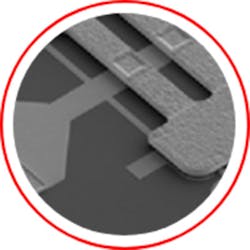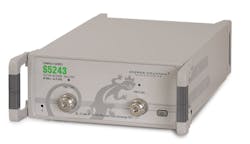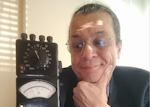This article appeared in Evaluation Engineering and has been published here with permission.
A recent column in our sister publication Evaluation Engineering pointed out that even before our society was challenged by the latest cultural unrest, climate issues, and a viral pandemic, there was already a migration toward remote collaboration and telepresence technologies. These events are now putting the nascent application space through a stress test, as the solutions and their underlying infrastructures improve.
The trade show space was one of those migrating more slowly than most, in some ways, as face-to-face interaction is a powerful marketplace incentive. However, when it’s time to railroad, you lay rail, and so the industry must adapt. That’s why the International Microwave Symposium (IMS), the largest gathering of RF and microwave professionals, went virtual this year, due to COVID-19 (Fig. 1).
The flagship conference of Microwave Week, this year's event centers around the theme "Connectivity Matters," highlighting five pillars that link the world: communications networks, aerospace and defense programs, autonomous vehicles, the digital economy, and connecting under-represented communities around the world.
IMS is the annual conference and exhibition of the IEEE Microwave Theory and Techniques Society (MTT-S). This year’s Virtual IMS, as always, features a large commercial exhibition and a technical program offering technical sessions, interactive forums, plenary and panel sessions, technical lectures, application seminars, and other technical and social activities. Next year, IMS2021 will be held June 6-11, 2021, in Atlanta, Ga.
Sessions and Keynotes
The sessions covered a gamut of topics, from advanced materials and topologies to new application spaces and industries. For example, FormFactor held a workshop on best practices for thermal-on-wafer S-parameter measurements (Fig. 2). The company’s Craig Kirkpatrick and Gavin Fisher explained the best methods for setting up, calibrating, and evaluating measurement performance in coaxial probes up to 145 GHz and in waveguide bands spanning WR15 (75 GHz) to WR1 (1100 GHz) over a broad (–40 to 125ºC) temperature range.
They presented a novel means by which a directly connected waveguide probe can still be used for reliable overtemperature testing on a semi-automated wafer prober, and maintain ease of operation. Practical programming examples using WinCalXE software were also demonstrated for automating data measurement and analysis for on-wafer parametric measurements, and to evaluate system stability and performance.
A Better Switch
Among the new topologies introduced during the show was from Menlo Micro, which created and advanced a more sophisticated version of the venerable electronic switch. This switching technology, known as “Ideal Switch," brings significantly improved capabilities to electronic design and next-generation applications.
The Ideal Switch is presented as the world’s smallest and most efficient, while meeting industrial reliability standards (Fig. 3). The Ideal Switch offers major reductions in size, weight, power, and cost (SWAP-C), addressing industries such as medical, aerospace and defense, telecommunications, consumer electronics, industrial IoT, and test and measurement.
Today’s switches are designed for specific application requirements, and all come with tradeoffs. Menlo Micro’s “Ideal Switch” technology combines the benefits of electromechanical and solid-state switches. The Ideal Switch operates up to 1000X faster than a typical mechanical switch, can switch on and off three billion times without degraded performance, handles kilowatts of power, and is contained in a structure smaller than a human hair.
Prototyping Radar and EW Systems
Dealing with phased-array radar and other advanced microwave systems involves management and synchronization of multiple channels. One solution presented at the event was Analog Devices' (ADI) multipurpose 16-channel phased-array radar, electronic warfare, and SATCOM platform based on four of the newly released AD9081 MxFE ICs.
Targeting applications such as phased-array radars, electronic warfare, and ground-based SATCOM—specifically, a 16 transmit/16 receive channel direct sampling phased array at L/S/C band (0.1 GHz to ~5 GHz)—the Rx and Tx RF front-end has drop-in configurations that allow for customized frequency ranges, depending on the user’s application.
In this video, ADI’s Mike Jones explains the system:
The Quad-MxFE System Evaluation Board is intended as a testbed for demonstrating multichip synchronization as well as implementation of system level calibrations, beam-forming algorithms, and other signal processing algorithms. The board is designed to mate with a VCU118 Evaluation Board from Xilinx, which features the Virtex UltraScale+ XCVU9P FPGA, with provided reference software and HDL code.
Connecting the world with mmWave
Even a virtual show has booth giveaways. On the Keysight page at the show they were giving away KeysightCare masks to anyone who provided their mailing address. They even had a daily virtual “Happy Hour” with online connected Keysight Experts. The company was also touting millimeter-wave technology as a key enabler for next-generation wireless solutions to deliver more performance to connected devices.
Among other solutions, the company was promoting its VXG Microwave Signal Generators, presented as the first dual-channel 44-GHz vector microwave signal generators with 2-GHz modulation bandwidth in a single instrument. They overcome OTA system path-loss challenges that mmW technology brings with the industry’s highest output power versus EVM and ACPR performance, and accelerate product development cycle and confidence in 5G NR component characterization using PathWave Signal Generation.
Addressing 5G applications, the solutions enable you to tackle the multitude of 3GPP conformance test configurations for receiver blocker and interference testing with two 44-GHz channels. Automatic channel response correction and S-parameter de-embedding improves measurement uncertainty and accuracy in wideband 5G carrier aggregation scenarios, and PathWave Signal Generation software accelerates design and test workflow.
A Compact High-Frequency VNA
Created in 2011 and based in Indianapolis, Indiana, Copper Mountain Technologies develops innovative and robust RF test and measurement solutions. The company’s VNAs include an RF measurement module and a software application that runs on an external Windows or Linux laptop or tablet, connecting to the measurement hardware via USB interface. The result is a faster, more effective test process that fits into the modern workspace.
Their S5243, a 2-port, 43.5-GHz vector network analyzer (VNA), is CMT’s highest-frequency Compact VNA (Fig. 4). It features excellent dynamic range and fast measurement speed in a compact package with the maximum standard software feature set. The S5243 VNA includes an RF measurement module and S2 Windows or Linux operating system on a PC, laptop, tablet, or x86 board computer connecting to the measurement hardware via USB interface. S2 software can be installed on multiple computers, making it easy to share the use of the analyzer measurement module.
Emphasis on History
At the Anritsu virtual booth, there was a video running about the company. Founded in 1895, the year in which Marconi successfully demonstrated the world's first wireless telegraph, Anritsu celebrates 120 years this IMS2020.
Anritsu is developing next-generation high-frequency components and test equipment for mmW technology such as its Modular 2-port ShockLine VNA, and Extended-K and W1 components.
This video introduces the latest addition to the ShockLine family, the ME7868A 2-Port VNA system. It is a new concept in VNAs: a configurable modular architecture that takes two ShockLine MS46131A 1-port VNAs and combines them into a fully reversing 2-port vector network analyzer.
Fast and Accurate Test Solutions
The pressure to develop better, faster, efficient, and more economical wireless solutions is relentless. Even a mature space like automotive is challenged at every turn by the need to incorporate advanced wireless functionalities. At the newly-renamed NI (formerly National Instruments) booth, the company emphasized its role as a development partner, collaborating with you to overcome challenges with fast and accurate RF and mmWave test solutions that scale from validation to production test.
NI’s Vehicle Radar Test System (VRTS) provides automated radar measurement and obstacle simulation capabilities for 76- to 81-GHz automotive radar systems with 1 GHz and 4 GHz of bandwidth. VRTS easily integrates with other PXI measurement hardware for a comprehensive automotive radar test system.
The VRTS can test the hardware and software components of a vehicle, including radar sensors, ADAS subsystems, and embedded software. The combination of high-performance mmWave radio heads and the Vector Signal Transceiver helps engineers conduct precision RF measurements for beam characterization and testing while generating user-configured scenarios for the test. As a result, engineers can utilize the same measurement hardware for all phases of ADAS and radar system development, from R&D to high-volume manufacturing test.
Microwaves Matter
Mini-Circuits is a leader in the design, manufacture and distribution of RF/IF and microwave components and integrated modules covering the dc to 86-GHz range. The company has been growing rapidly, expanding some of its product lines by as much as 50% in 2020. The latest version of Mini-Circuits' Microwave Calculator app now includes 31 RF/microwave calculations commonly used by engineers in the lab and in the field. New functions include frequency to wavelength conversion, voltage-divider circuit analysis, Ohm's Law circuit analysis, and more.
Android: https://play.google.com/store/apps/details?id=com.minicircuits.android.mclcalc
iOS: https://apps.apple.com/us/app/mcl-microwave-rf-calculator/id1003935816
The app also features a fully redesigned user interface for improved navigability and user experience. The Microwave Calculator app is a handy mobile tool for RF engineers to make common calculations on the fly. It can perform 31 calculations often used by RF and microwave system designers at the design desk, on the test bench, or in the field. Some popular calculations include the effect of VSWR or return loss on transmitted power; cascaded gain and noise figure for up to five amplifier stages; and power-to-voltage conversion.
Check back again in the next few days for more coverage from the event!





